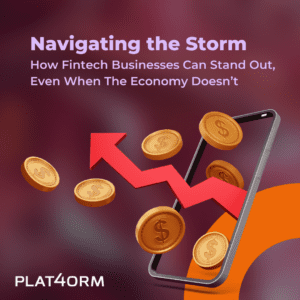
Fintech as a sector is under pressure and while there are many ways to survive these economic storms, customer messaging strategies may be the last survival tactic that comes to mind. But that can’t be farther from the truth.
As a sector, Fintech’s reach is huge. The apps, software and technology that allow people and businesses to access, monitor and manage their finances or easily and quickly make financial transactions is expanding almost daily. As part of the financial picture, Fintech has become embedded in the landscape.
During an economic downturn or recession, the financial world itself often gets cast as the villain – isn’t it the money managers‘ fault that we’re in this predicament? As businesses grapple with increasing layoffs and the specter of impending financial doom, it doesn’t seem like there’s much Fintech can do to set itself apart as a “good guy.”
Despite that challenge, Fintech businesses can still thrive and differentiate themselves by leveraging some key messaging strategies: Let your customers know their needs are your focus, let them know you’re staying innovative and agile, let them know you’re working to retain their trust, and show your stability by building bridges with traditional financial institutions.
The Customer Is Your Total Focus
As a Fintech firm, this should actually be your time to shine. Your customers want to feel confident in your expertise when it comes to managing their money during tough economic times. How do you do that? By preparing market messaging scripts and talking points. In all your engagements with clients, it’s important to stress that you understand their concerns and empathize with their needs right now.
Using your customer data, you can offer clients personalized experiences designed to boost their confidence. If they’ve indicated an interest in home improvement or auto loans, for instance, emails detailing your loan programs long-term success can prove enticing. Have they inquired about investing opportunities? Texts and social-media ads specifically targeted to clients who have indicated an interest in personal finance offerings such as bond funds let customers know you want to help them grow their investments safely during downturns.
Klarna has found huge success by giving customers the option to pay for items over time with no interest fees, even merchants who aren’t part of Klarna’s network. This is especially attractive to Millennials and Gen Zers who are still getting their financial footing and want to spread payments of bigger-ticket items out over time without high interest rates. In the U.S., Klarna now boasts 34 million users, and in Germany more than 80% of all adults use the system. Klarna’s customer-focused strategy and market messaging about it was purposeful and bared fruit.
Stay Innovative and Agile
Keeping an eye on trends and customers’ habits is key to offering them what they want when they want it. Fintech companies especially need to continuously adapt to changing market conditions, taking their cues from clients.
During the height of COVID-19, for example, Klarna’s CEO and co-founder Sebastian Siemiatkowski saw active use of his app explode to 6 million monthly U.S. users as of February 2022. To capitalize on the app’s popularity, he developed a browser that makes any retail website usable with Klarna – and then released the Klarna Card last June to a waiting list of 1 million people, giving them a physical card they use to pay over time in four equal payments with no interest or down payments for nearly any item available online or in person. He’s also evolved the site to serve as an end-to-end shopping experience, offering customers delivery tracking, digital receipts, money management tools, price-drop notifications and wish lists.
By February 2023, Klarna had more than 8 million monthly users in the U.S. – and anticipates millions more by next year.
That kind of innovation that responds nimbly to subtle shifts in customer demand can change more than just retail sales. Payment powerhouse Square’s system helped change the way people pay for all goods and services in less than 10 years. Fourteen years ago, the company’s founders saw that people were increasingly using plastic credit and debit cards for payments. They came up with a tiny, square card reader that could attach to any smartphone or tablet, and marketed it as a way for artists, musicians and small, independent merchants to accept credit cards for sales anywhere.
Just a few years later, they started offering their hardware in stores to meet increasing demand. To reach even more people, the founders adapted the device to an app – and watched their sales skyrocket. They kept looking for new ways to serve clients. Square, now called Block, has morphed into a $54 billion fintech company. Its consumer-payments platform, Cash App, is now the country’s No. 1 finance application. Block is also an FDIC-insured bank and handles payroll, sells stock, trades cryptocurrency and has made high-profile acquisitions, including Jay-Z’s Tidal music streaming service and Caviar – which it sold to DoorDash. [PW1] Current Block CEO Jack Dorsey notes that the company plans to keep seeking new ways to stay on top of client needs: “No matter how we grow or change,” he said, “we will continue to build tools to help increase access to the economy.”
Build Trust with Customers
With data breaches in the news almost daily, safeguarding customers’ financial data is critical. To maintain customers’ trust, make sure you not only prioritize robust security measures, but also let customers know about those measures to reassure them. Use traditional and social media, email, texts, direct mail and your website to trumpet the extra steps you take to maintain their data privacy.
Keep your communications with them steady, letting them know on their digital and even paper statements what you’re doing to keep their money and their data safe. You can also keep clients informed about current financial scam trends, how to maintain their own digital safety and how their investments are faring given the uncertain economy. Emphasizing these themes will help you establish transparent communication channels and keep customers reassured that you have their backs.
Lithuania-based Revolut provides a good example. It relies on its security features and its user-friendly interface to both keep data and money safe while infusing clients with confidence in its protection. In addition to offering increased levels of financial data protection, its business account allows international businesses and freelancers to streamline expenses and reduce paperwork and costs for exchange rates and cross-border transfers, while also cutting through bureaucracy and keeping information secure. Revolut emphasizes its practice of keeping clients’ funds separate from its own in segregated accounts and of insuring each customer’s deposits up to about $110,000 under Lithuanian law. Communicating these measures has helped the app garner nearly 16 million satisfied users across North America, Europe, Australia and Southeast Asia.
Show Stability With Your Partnerships
Many Fintech startups have innovative technology and great ideas about how to find customers. But the savviest of them understand that strategic partnerships can best help them leverage established networks and resources – and increase customer confidence in their ability to keep their cash and investments safe in a downturn. In order to communicate this to the outside world, preplanned customer messaging exercises make for high-return business strategies.
Partnerships do more than just enhance your credibility, however. They also help expand your customer base. Those clients who are already with that established financial firm? They’re your potential customers, too, and once you pair up with their firm, they’re primed to start working with you.
Wise’s partnerships with banks is a good example of cross-border transfers and how well they can work. The international money-transfer app that started in 2011 as TransferWise focuses on affordability and justice, and partners with traditional banks in 160 countries to send money where you need it to go, minus the 5% international transfer fee most traditional banks charge. AvidXchange, Google Pay, Stanford Federal Credit Union, GoTrade, Aspire and ZA Bank are just some of the banks that partner with Wise, allowing it to offer customers interest, insured deposits and even a debit/credit card. Wise also touts its safety features that are linked with partners, such as holding money in established banks and the creation of a dedicated fraud team that can work across borders.
By communicating to customers their total client focus with purposeful customer messaging, commitment to innovation, trust-building efforts and collaboration with traditional financial institutions, Fintech firms can set themselves apart from the rest of the finance industry as a reliable place to manage your money even during a recession. Spotlighting the resilience and potential of Fintech businesses sends customers the message that their money is safe and that the winds of a downturn won’t blow their houses down. For Fintech entrepreneurs, the challenge of a downturn might be exactly the right time to seize growth opportunities. Rely on your marketing and public relations communications skills to get the right customer messaging script.

